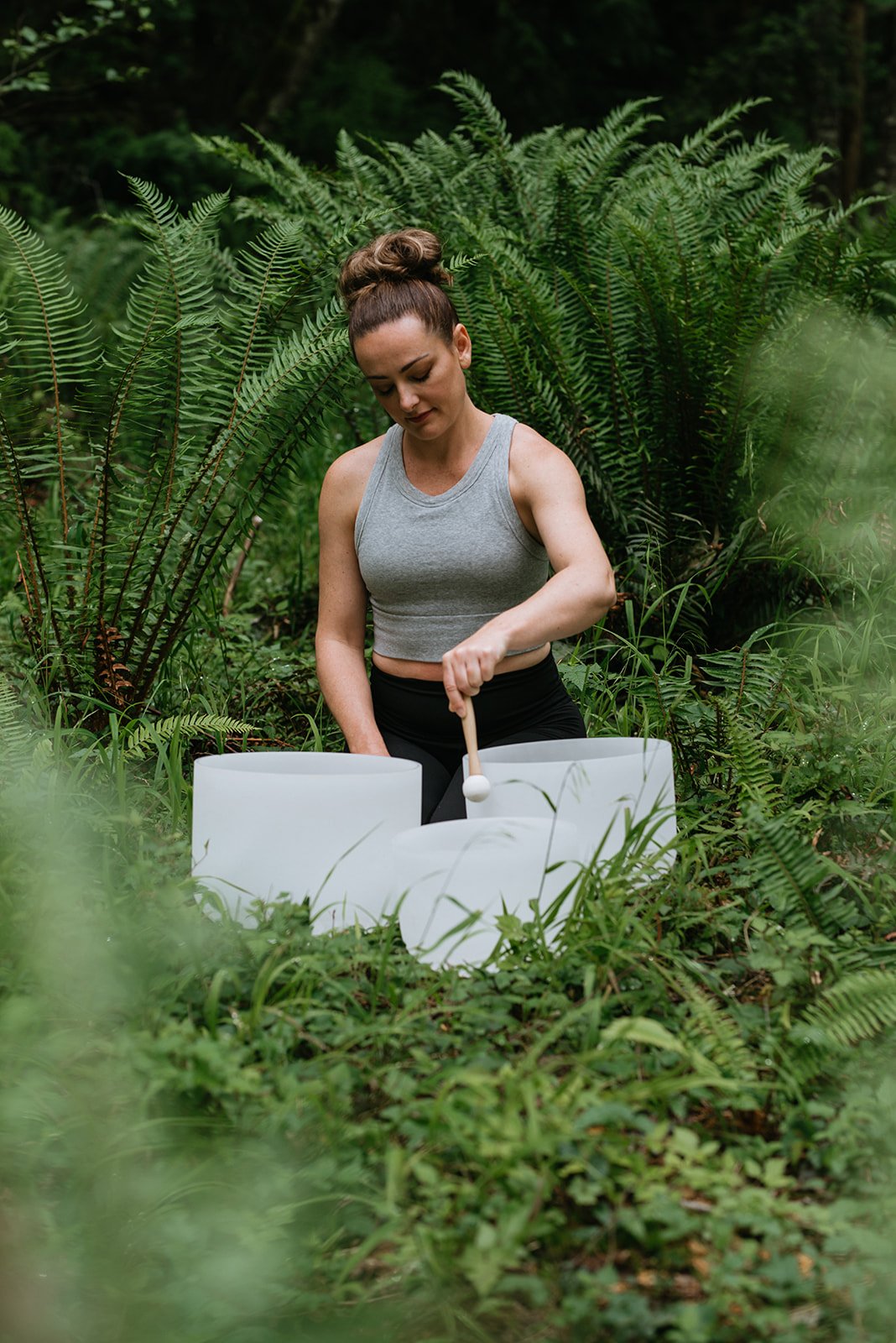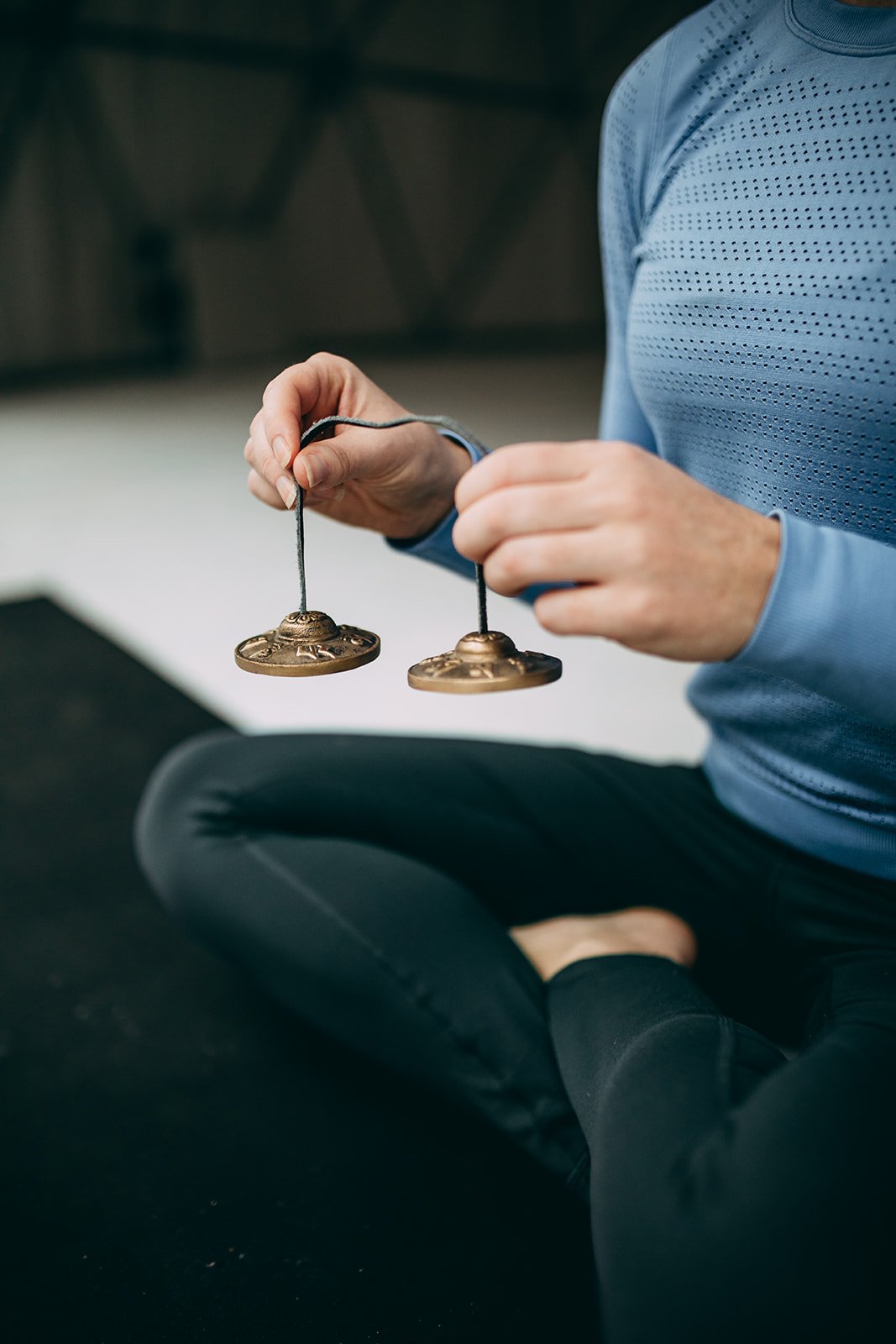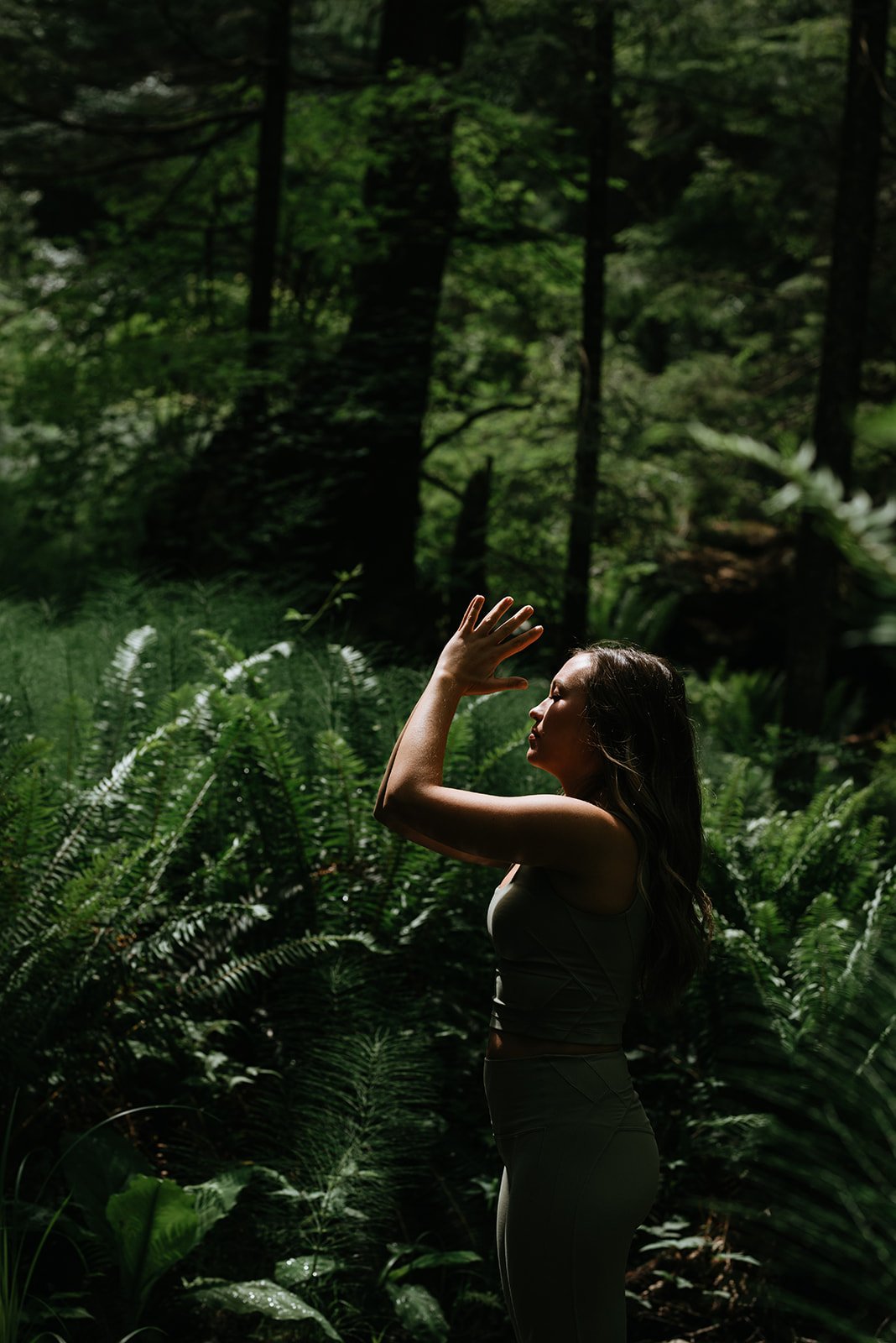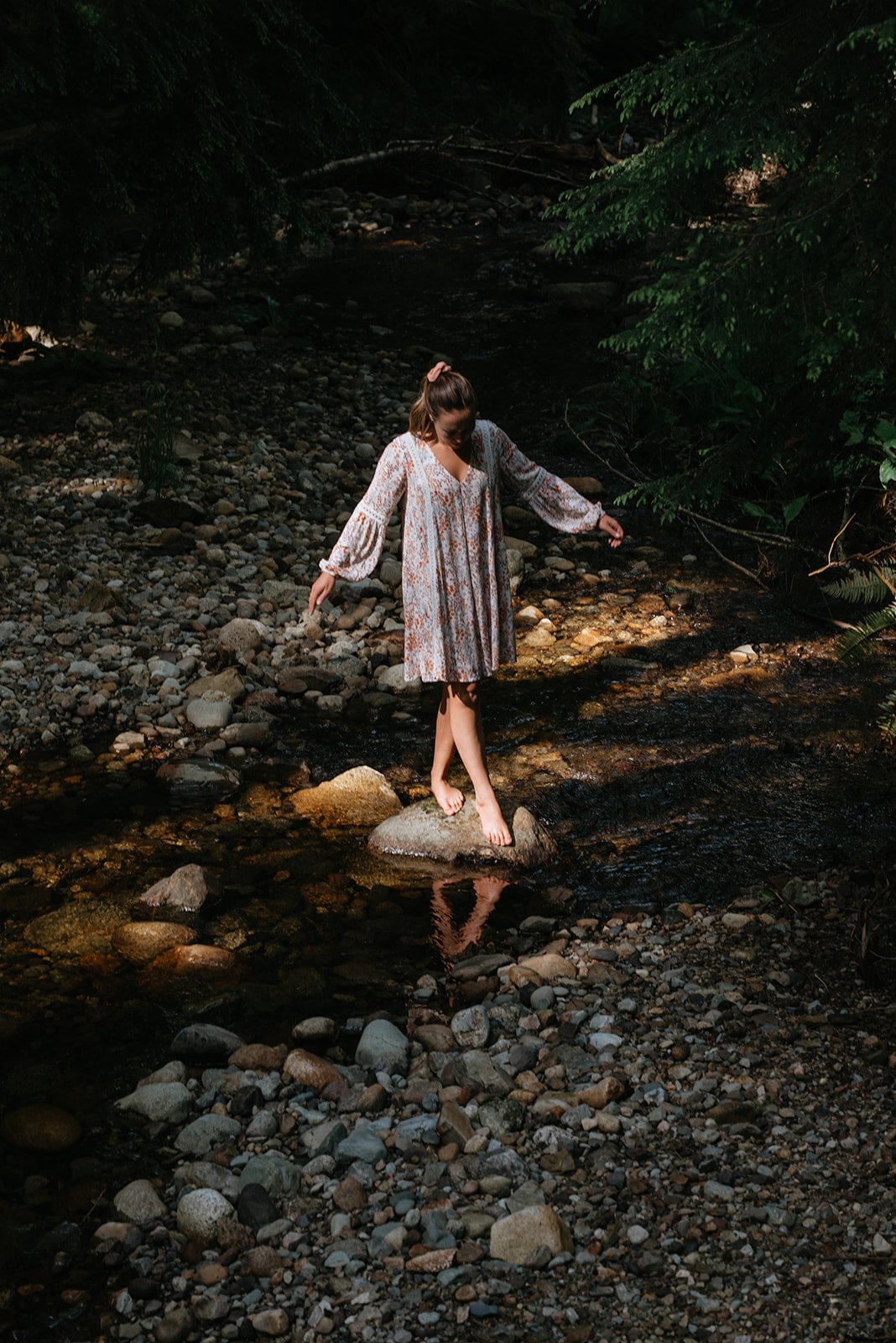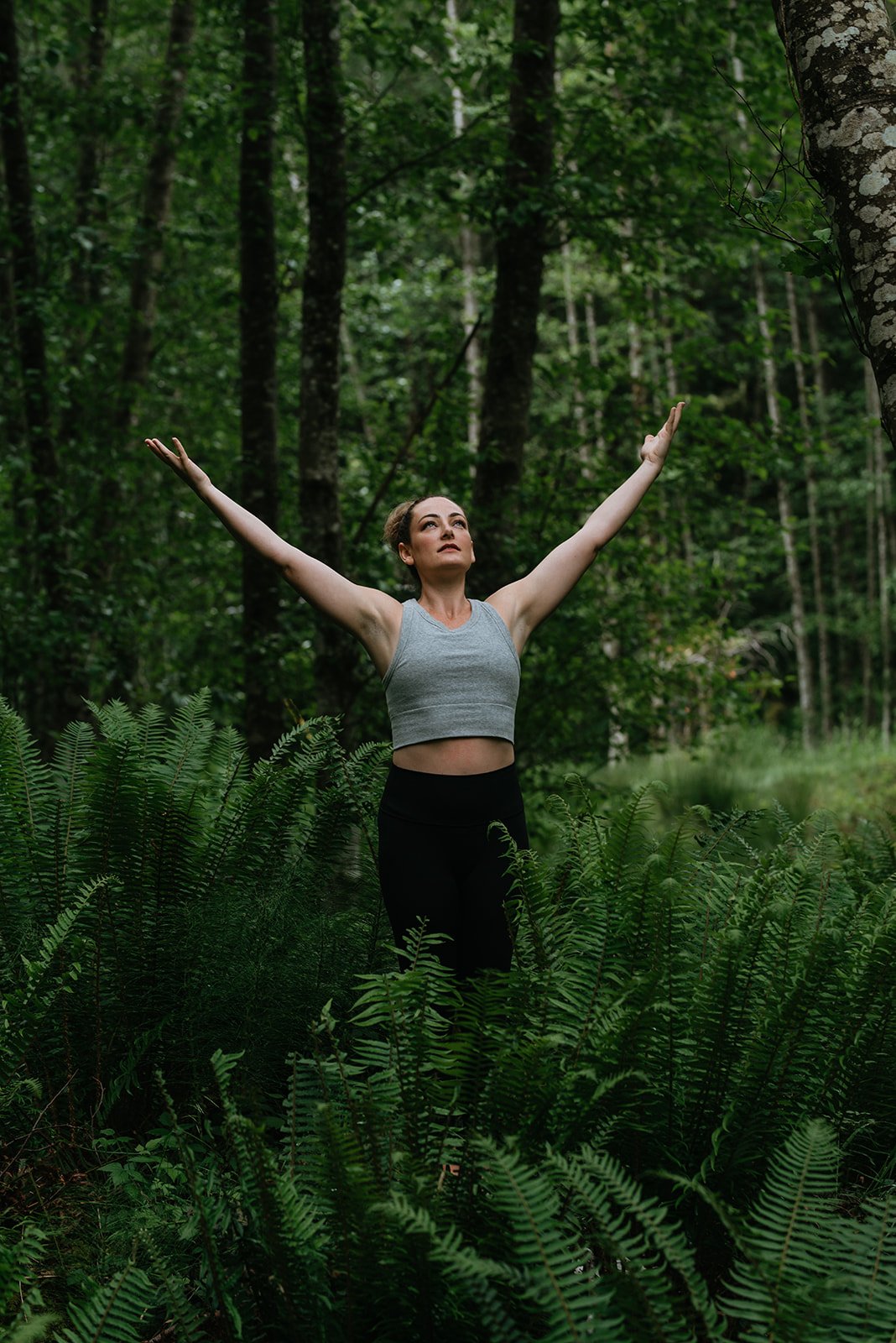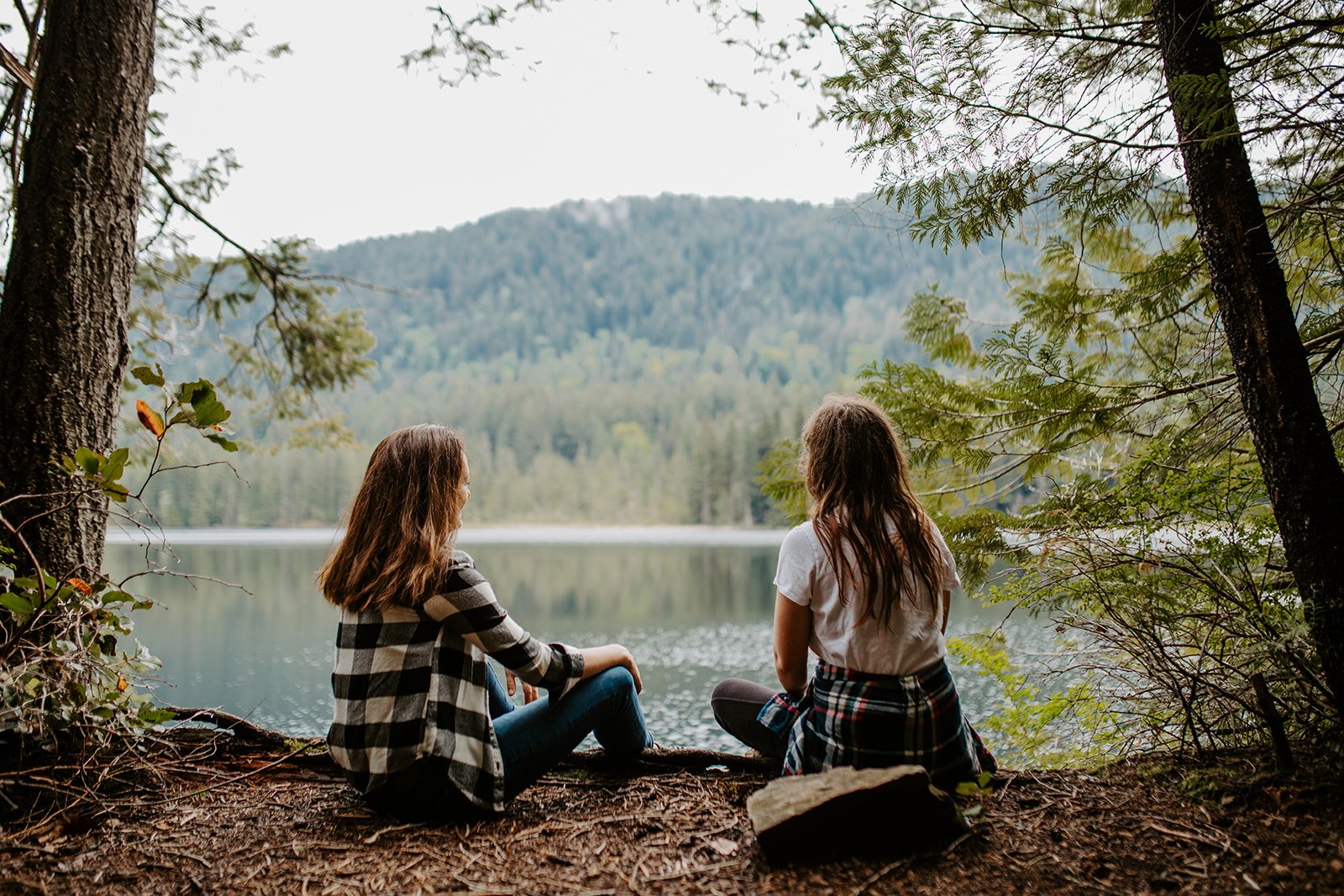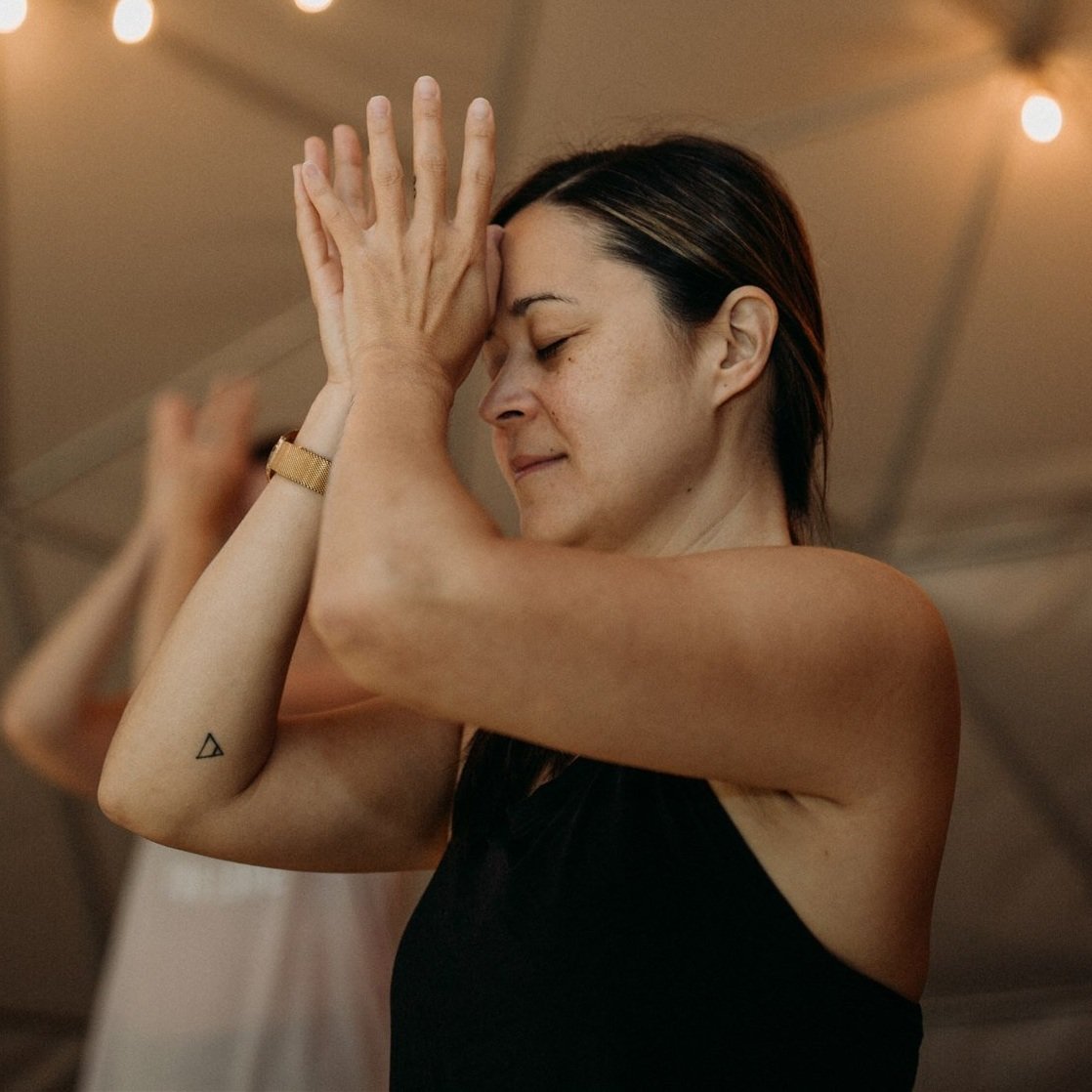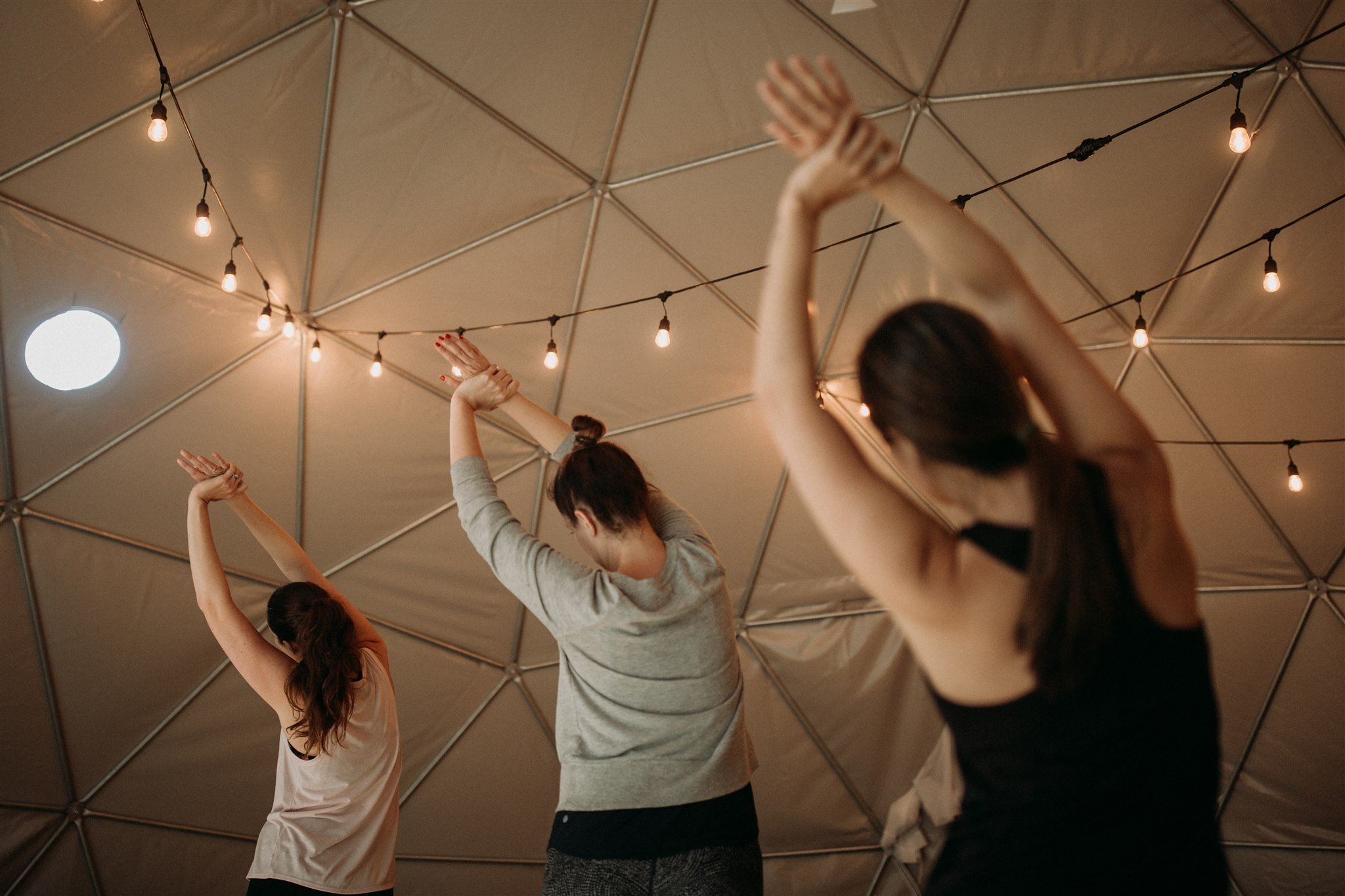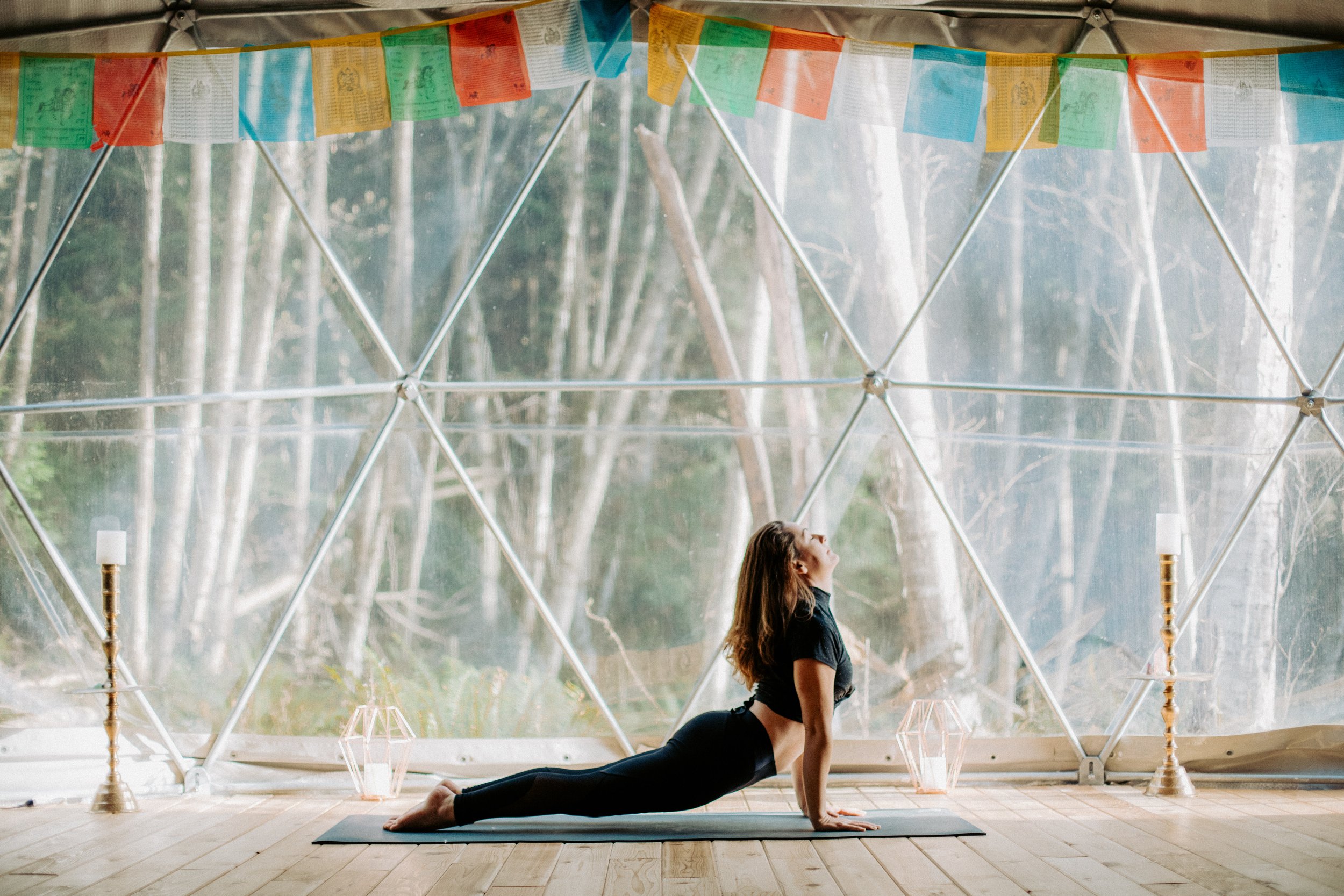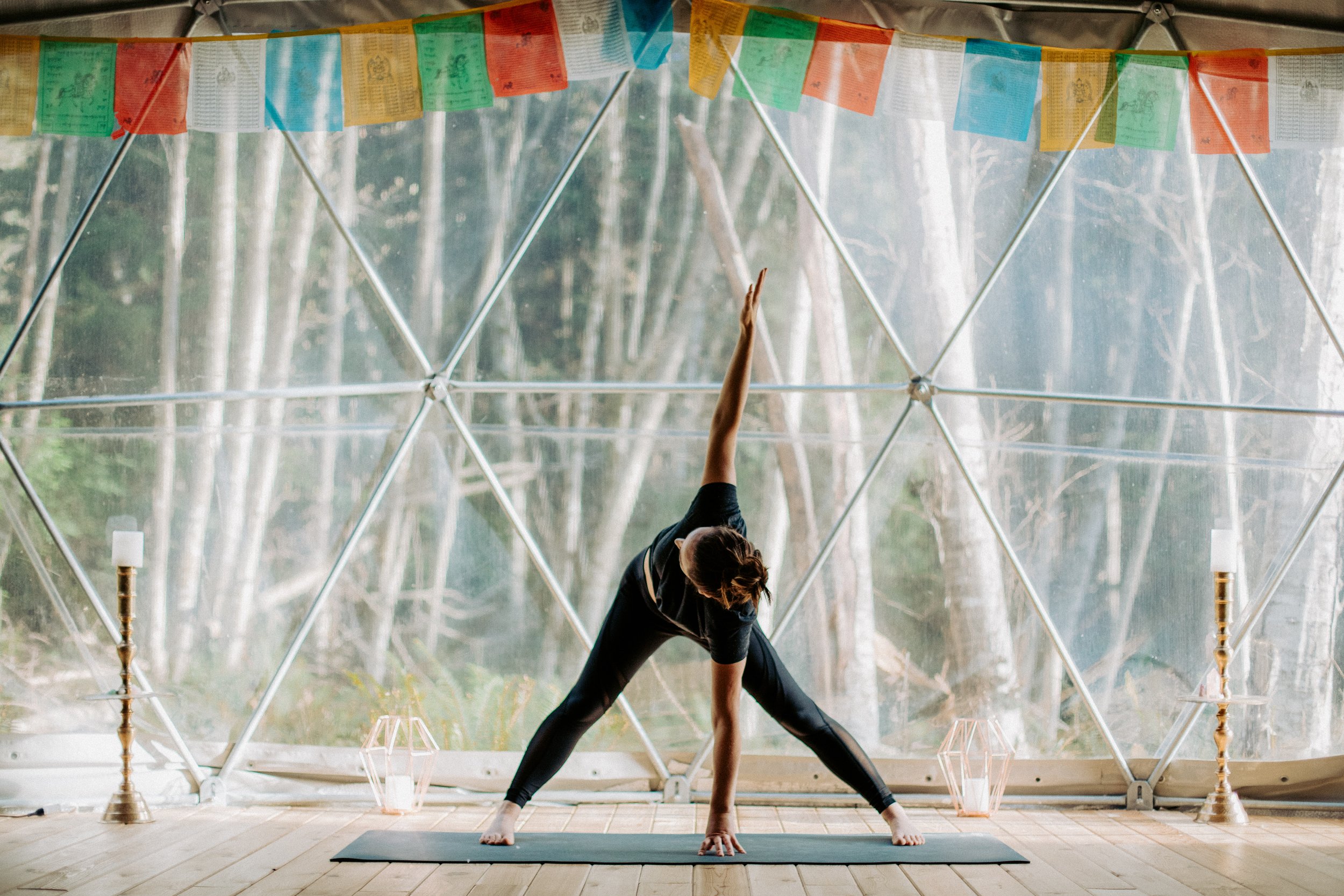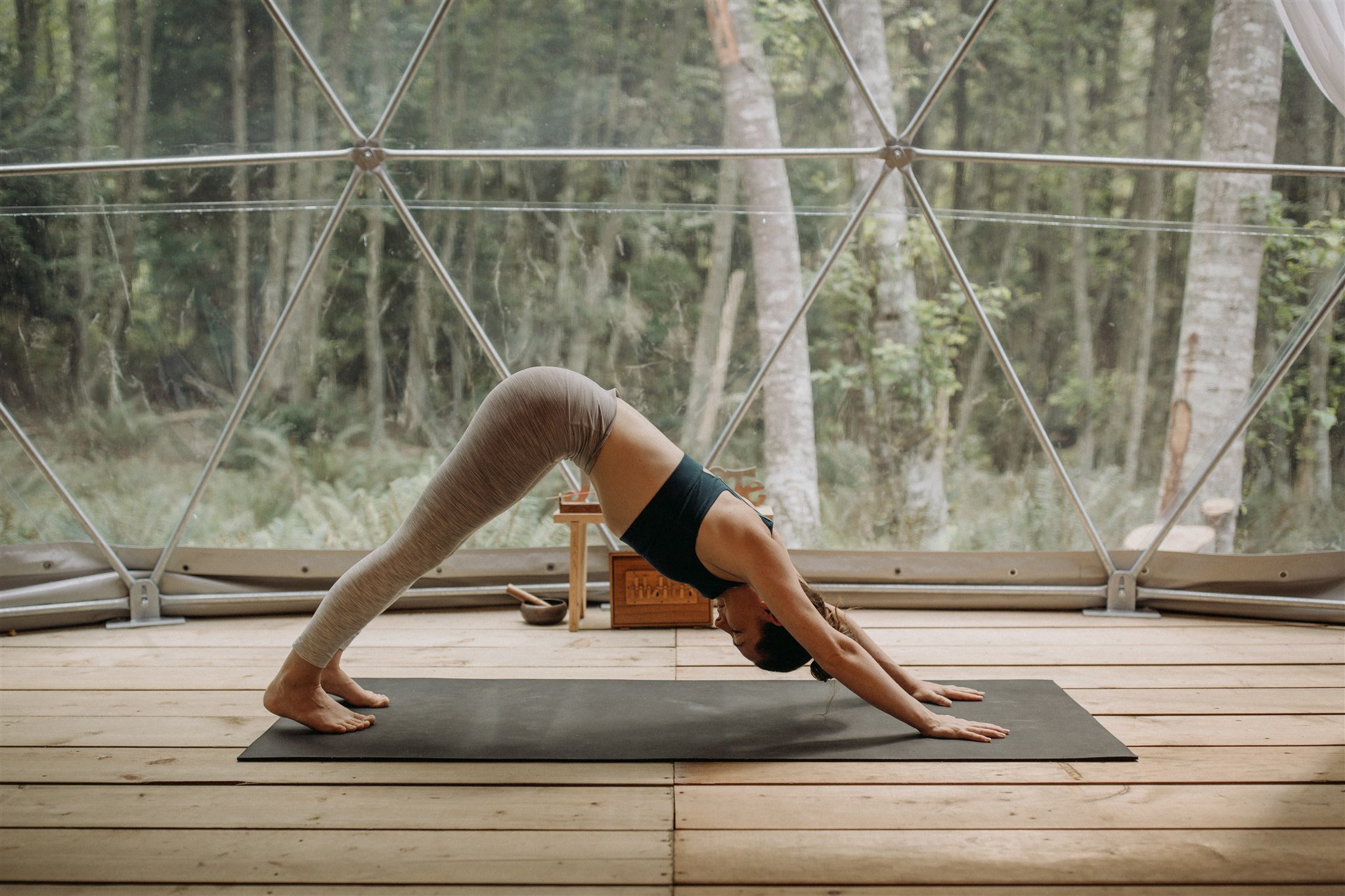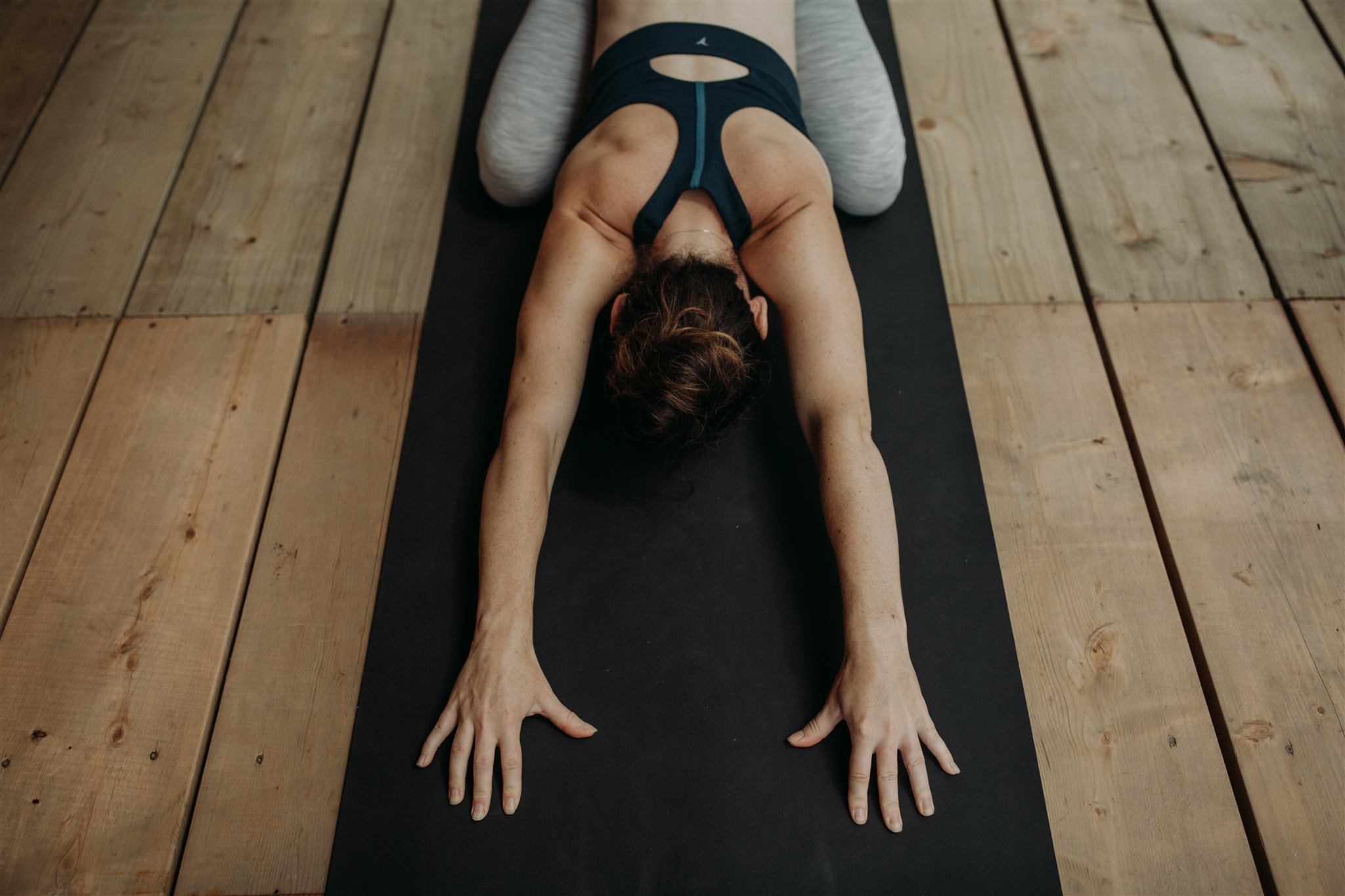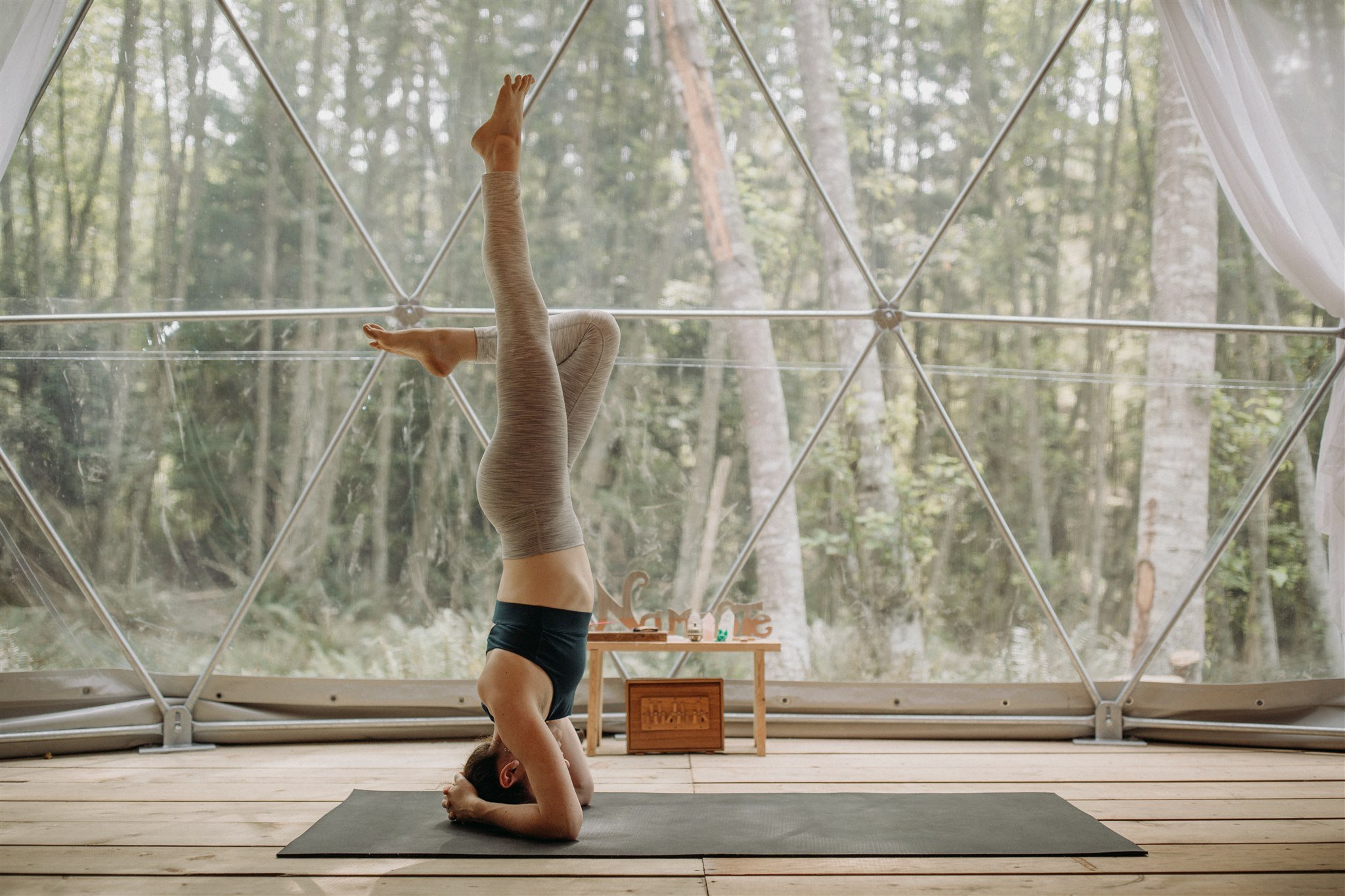Pine trees, belonging to the genus Pinus spp., stand as stalwart guardians in the forest network. These evergreen conifers, characterized by their needle-like leaves and distinctive cones, possess an enduring visual and fragrant allure. Their presence is woven intricately into the fabric of our ecosystem, offering both tangible and intangible gifts to the environment and its inhabitants, including here at Nectar Yoga Retreat on Bowen Island.
To the Mosses: Ecological, Functional, and Spiritual Uses of Moss
Mosses’ diminutive size belies their resilience, tenacity, and ecological significance. Mosses are essential for retaining soil and moisture (as much as 40 times their weight), preventing erosion, and providing homes, insulation, and sustenance for various organisms in their ecosystems, including at Nectar Yoga Retreat on Bowen Island.
Isvara Pranidhana: Surrendering to the Sacred
At its core, Isvara Pranidhana calls upon us to release our grip on the illusion of control. The practice urges us to let go of the ceaseless pursuit of ego-driven ambitions and the false belief in our hyper-individuality-based abilities. Here at Nectar Yoga Retreat, sitting with humility as a teacher is a lifelong journey.
Saucha: Cultivating Clarity in Ancient Yogic Philosophy
The practice of Saucha extends to our relationship with the land. It means centering and learning from the Indigenous groups, such as the Coast Salish peoples, and traditional earth-relating cultures. It calls for mindful consumption, reducing waste, and living in harmony with animals, plants, air, waterways, and other elements in Nature. It means a return to living and consuming seasonally. By being conscious of our ecological footprint, we acknowledge that humans are here for a reason, and to not waste this opportunity to steward this Earth. Saucha reinvites us back to circular living.
What Is Sound Healing + How Does It Work
Guest Blog Post by Mia Cara Cosco.
Sound healing has received significant media attention in the last few years alone for its numerous benefits and even celebrity attention.
Sound healing is an ancient art, given the historical significance of instruments going back seemingly as old as the dawn of civilization. History depicts sound healing has been exercised in various forms over time, from chanting to ward off evil spirits to playing music for mental health-related illnesses. Music has been used since to boost morale in military troops, aid people in productivity and so many more situations + cultures around the world.
Health Benefits Of Sound Healing
A trained practitioner is typically trusted to lead a sound healing experience, as it’s not actually as easy as hitting bowls or twirling a chime. Different aspects of music improve physical and emotional health.
Sound healing can also happen by way of moving along to the music in small or large motions. If meditating is something seen as “common”, then this is an act of going beyond simply listening to the music because you are also working to empty your mind of thoughts and resolve any fidgeting (which can be easy to do). Sometimes, sound healing can even be through the act of playing an instrument yourself. From experience, this can be a deeply soothing and contemplative experience that puts you in touch with a flow state.
Sound healing has had some interesting niche findings in the research, such as boosting immune function by lowering stress levels and improving the health of premature babies. Research has also found these general benefits:
reducing stress
decreasing anxiety
improving memory
reducing blood pressure
lowering cholesterol
minimizing pain
decreasing risk of heart disease and stroke
Much of these findings also correlate with mindfulness meditation — much of sound healing puts you in a state of inner flow and intentional stillness. Once the habits of fidgeting and intrusive thoughts are put aside to immerse yourself in it, the healing or noticeable effects of meditation or sonic frequencies can be felt potentially quite deeply.
Overall, with health as a primary value, it seems as though we have evidence to shift our focus from the typical model of health to a perhaps more ancient one. Sound healing has rebranded in white-washed western culture, however, the benefits have only become more well-known to science. Music and sound can change our state almost in an instant and this can be incredibly powerful for healing our body and mind.
What Instruments Are Used?
Any and all instruments can be ultimately used to heal, depending on what resonates with you and what sound you prefer, thus there really is no right answer to this. With that said, there are certain instruments designed and typical for sound healing studios that are worth mentioning:
hand pan
pan flute
chimes
harmonium
tuning forks
singing bowls
tongue drum
gong
harp
It is common for music therapists to use well-known instruments, such as the guitar or piano, for performances as well. More culturally specific instruments, such as the sitar or zither, can also be found depending on where you are in the world.
Your preference in music or what sounds you like to hear often occurs on a subconscious level and may not be something you can rationalize. If you’re interested in finding a sound healing studio or a sound healer to experience the technique first-hand, make sure to ask these questions in the process:
Are there specific types of music you like to listen to?
Are there music genres you are uncomfortable with?
Would you prefer to be moving or meditating while sound healing is happening?
Are there instruments you are more interested in hearing?
Are there instruments you don’t like the sound of?
What Sounds Are Right For You?
Let’s get into the specifics of what sound frequencies can be healing—and for what. This is helpful to know about the Solfeggio frequencies, rediscovered by the physician and research Dr. Joseph Puleo in the 1970s:
432 Hz—the standard tuning for ancient musical instruments pre-20th century, deeply calming and soothing which is best for sleep
528 Hz—ability to heal and repair the body even after just 5 minutes due to its stress reduction power in the endocrine system and autonomic nervous system
396 Hz—helps remove subconscious fears, worries and anxiety by eliminating feelings of guilt and subconscious negative beliefs to help you feel uplifted
639 Hz—balances emotions, elevates mood and promotes communication with harmony and understanding into interpersonal relationships
741 Hz—problem-solving, bodily cleansing and self-expression to awaken intuition and promote simple living to live a healthy lifestyle and express creativity
852 Hz—replaces negative thoughts with positive ones and aids in awakening intuition and inner strength for living in harmony with your highest self
Notice How You Feel
There is no use trying to endure an uncomfortable experience when the purpose is to heal. With that said, brief moments of uneasiness are inevitable in any new experience as humans. An instinctual yes or no is essentially relying on our sympathetic and parasympathetic nervous system. These are slower, gradual insights and realizations that come from a steady mindfulness practice overall.
I am supremely grateful to the gracious team at Nectar Yoga for the opportunity to write about one of my favorite loves, sound healing.
Many thanks as well to the sources linked in this piece, rich in knowledge and wisdom on various healing modalities and practices.
If you took something away from this piece or learned anything, tell me below! What did you take away from this or have you experienced the benefits of sound healing first-hand? I would love to see your comment!
All Photos - Nectar Yoga Copyright
Forest Bathing | The Benefits + How To Practice
There’s a reason why the largest cities in the world have parks, trees, + pockets of nature woven throughout their busy streets. Studies have found that spending 10 to 20 minutes a day outdoors can lead to an increase in overall well-being and happiness — and decreased amounts of stress; meaning these bits of nature added to urban life are lending a positive impact on a people’s day to day life.
Aside from spending time in city parks, the more in-depth practice of forest bathing has been proven to have physical + mental health benefits across the board.
The term ‘Forest Bathing’ references a physiological + psychological practice that emerged in Japan in the 1980s. This practice, also known as ‘Shinrin-yoku’, was cultivated to help people achieve two goals; to relieve feelings of burnout while also inspiring residents to connect with, and protect the country’s green spaces. Forest Bathing is an open-ended practice in the sense that there is no right or wrong way to experience it. It can be as simple as standing in nature and noticing the smells, sounds + sights the area provides you.
The Benefits Of Forest Bathing Include:
lower blood pressure
reduced levels of cortisol (stress hormones)
strengthens immunity
relieves anxiety
improves concentration
improves short-term memory
energizes the body + mind
improves mood
strengthens sleep patterns
While the word “forest” is in the name of this practice, heading to a rural wooded area is not required. You can take a trip to a nearby park, your favorite local trail, the beach, or any natural setting close by. The focus is to move through this practice with intention and mindfulness; meaning being present and fully in the moment. If you can, turn off or silence your phone or other devices that may distract or interrupt your time.
Once you’ve arrived at your chosen spot, take some deep breaths and ground yourself. Let yourself notice all that your senses are taking in — whether it’s the scent of towering trees or the sounds of chirping birds.
Allow yourself to spend a few moments observing your surroundings. You might choose to do this practice in stillness, movement or a combination of both. Sit and watch how the trees sway in the wind or simply walk around. If you decide to walk, go at a leisurely pace and without a specific destination in mind. It is important to let your mind and senses explore + indulge.
Safety tip: Always pay attention to your surroundings, stay on marked trails, + wear appropriate clothing/footwear. Consider things like sun protection or any possible allergies you may have; be respectful of nature around you, and leave no trace other than footprints. When possible, bring a friend or let someone know where you’re going and for how long.
A good rule of thumb is to practice forest bathing for at least 20 minutes every day. If you don’t have that much time to spare, that’s absolutely fine. You can start with a shorter amount of time. The goal of forest bathing is to relax + detach — this practice shouldn’t feel like a chore. The aim is for this to be something you look forward to and enjoy.
No matter how much time you spend outdoors, remember to look for moments that bring you to awe. You can also tie your forest bathing practice to your journaling practice (we have a whole blog post about different journal practices for you HERE).
After each session of forest bathing, use your journal to note your experience or any thoughts you had while immersed in nature. This is a good way to keep track of how the practice is making you feel over time — and help you create an additional ritual that supports your overall heath.
Gratitude to our community near and far, both for taking the time to explore our blog and for walking the path to your best self - we hope this resonated and aids you in finding balance within.
Thanks and credit goes to the resources for this blog provided by the writers and healthcare professionals at Kaiser Permanente
Let us know in the comments where you like to spend time forest bathing or how you feel about it.
All Photos - Nectar Yoga Copyright
Finding Your Practice | How To Start + Continue On Your Yoga Journey
Whether you’re starting your yoga practice fresh, or coming back to it after some kind of hiatus, the benefits + gains from it are truly wonderful whilst versatile. However like most new endeavors, when we are in the beginning stages it’s easy to feel overwhelmed, unsure and unmotivated.
Which is why we' have compiled a (hopefully) helpful list of not only the benefits of cultivating your own personal yoga practice, but what lineages you might resonate with, what to look for in modern yoga studios as well as teachers.
Most importantly as you begin to practice yoga, know that this is much more than a form of exercise (that’s yoga Asana, we did a whole blog just about that HERE)
The movement practice of yoga can bring a wide array of physical and mental health benefits, as well as moral lessons that can be applied to day-to-day life “off the mat.”
In Sanskrit, the word ‘yoga’ translates to ‘to yoke’ or ‘union.’ The practice thus encourages us to unite our thoughts, feelings and actions to our present state, while moving forward on a personal path that will allow us to be the best version of ourselves, contribute to the greater good of our communities and society overall.
Some things to consider and reflect upon as you start your search for yoga classes:
How do you typically feel when you try new things and what helps motivate you to stick with it when you feel uncomfortable?
Do you prefer in person or online classes?
Do small or large class sizes feel more appealing?
If you’re choosing online, how often will you go to in person classes? (this is important to check in for proper alignment cues)
Health Benefits: Why Do You Want To Do Yoga
Our sympathetic nervous system controls our fight or slight response. And with daily stresses being the main trigger of this survival mechanism rooted deep in us, we may find ourselves uncontrollably releasing excess adrenaline, a hormone that increases your heart rate and breathing.
This fight-or-flight response helped our ancestors escape or make their way through dangerous situations, like a charging bear, however in the modern-day, the stressful situations we find ourselves in general are not the same life or death threats as our ancestors experienced, thus the adrenaline released is overly excessive. Yoga is excellent at activating the parasympathetic nervous system (which controls the rest + digest aspects of our body) and developing a relaxation response that counters chronic stress.
Other Health Benefits Of Yoga Include:
Improved sleep patterns
Improved strength, flexibility + balance
Increased energy
Less chronic pain
Lighter moods
Can help lower blood pressure
Many people start yoga as a path toward improved health, reduced stress and self-discovery. A sustained yoga practice can help you fulfill these goals.
If going to a modern yoga class is something new, you’ve moved to a new city/area or are coming back to the practice after a personal hiatus, ask yourself the following questions:
What Do You Want To Accomplish?
Your goals may include:
Improved flexibility + balance
Increased strength
Stress reduction
Gain more body awareness
Next, think about what type of class you might prefer. Are you more interested in a relaxing, slower class or an active and challenging one?
Before choosing, we recommend talking to your healthcare provider to make sure the movement practice of yoga is safe for you.
From there, start with a class deemed All-Levels, or even better, something specifically curated for beginners. Look for a beginner Hatha, Yin or Restorative class to attend. If you have some experience and want a class that incorporates more physical movement and strengthening, try Ashtanga or anything labeled ‘Vinyasa’ or ‘power yoga.’
All yoga studios should offer descriptions of their classes and be able to answer any questions you have beforehand. Whether you’re a beginner or an advanced yoga student, there is a class out there that meets your needs.
What Are The Staff + Instructors Like?
A yoga studio with friendly, experienced + helpful instructors will help to motivate you to keep coming back. During your first visit, the studio staff should:
Greet you with kindness
Inform you about the available equipment, such as mats + props, and where you can find it
Offer a tour of the facility
Review the rules of the studio and what to expect with each class
Do You Feel Comfortable During The Class?
Yoga classes should be accessible + inclusive. They should offer a welcoming, supportive environment free of judgment and competition. You should never experience pain or discomfort or feel forced into anything. Be sure attend and support classes that allows students to advance at a pace that’s comfortable and individualized.
As you experience different yoga classes, you’ll find that some classes align with your ideals more than others. Finding a class that focuses on the breath, promotes meeting yourself where your are and makes you feel safe is what matters most.
Find A Teacher Who Will:
Encourage you to stay within your limits. Most yoga injuries happen when you let ego take over and push yourself too hard
Focus on breathwork throughout the class. Breath is the foundation of yoga and is paramount for a healthy, sustainable + proper practice.
Help you modify the postures based on your abilities. This might include using props to help support you or a chair if you can’t lie on the floor, giving cues to safely get you in and out of poses, and offering modifications to poses to make the class accessible to all in attendance
Gratitude to our community near and far, both for taking the time to explore our blog and for walking the path to your best self - we hope this resonated and aids you in finding balance within.
Thanks and credit goes to the resources for this blog provided by the writers at Cleveland Clinic and Jade Yoga
Let us know in the comments below what motivates you to go to yoga class?
All Photos - Nectar Yoga Copyright
What Is Asana?
This limb has become equated to ‘the yoga practice’ in the modern western world, yet it is only one of many other limbs that make up the true yoga practice. In the yogic view, the body is a temple of spirit, the overall and complete care of which, is an important stage of our spiritual growth.
Through the practice of physical postures we develop the habit of discipline + the ability to concentrate, both of which are necessary for cultivating healthy routines in life.
Asana is outlined in Patanjali’s Yoga Sutras, a collection compiled around 400 C.E. This was the first text to codify the practices of yoga, and is considered to be the foundation of classical yoga philosophy.
Sutra 2.46 outlines the qualities required in order to practice asana: “Sthira Sukham Asanam”. In Sanskrit, Sthira translates to strong, steady or stable, whilst Sukha translates to: ease, comfortable, relaxed. From this, Asana is described as a balance between stability + ease.
The Yoga Sutras only refers to postures used for seated meditation, however this description of Asana is also relevant to standing postures and all modern forms of the practice. Regardless of the style of yoga, practitioners are generally encouraged to seek a position that is both steady and comfortable.
According to Patanjali, the primary focus of Asana is to move to, and maintain a long and upright spine in order for energy to flow freely during seated meditation. Although modern Asana alignment cues are not limited to seated postures, you may notice that teachers will still tend to focus on the direction and free flow of energy within the body during a class.
Different texts and teachers throughout history have outlined varying numbers of Asana. The classic texts of Hatha yoga as taught by Lord Shiva, account for 84 postures, specifically highlighting that the first four are necessary to achieve spiritual perfection.
These postures are:
Siddhasana (Accomplished Pose)
Padmasana (Lotus Pose)
Bhadrasana (Gracious Pose)
Simhasana (Lion Pose).
Other scriptures, such as Gheranda Samhita (which highlights a seven-fold yogic path,) suggest that there are as many as 8.4 million yoga postures, to reflect one for each living creature in the universe.
More recently, Sri Dharma Mittra compiled a list of 1,300 Asana.
Different Types Of Asana Yoga
Hatha
Beginning with the foundational yogic tradition, Hatha yoga consists of asanas ideal for the beginner student. Poses are typically gentle with a moderate amount of flow. The pace is slower than most forms of yoga and the practice accessible to people of all ages and levels of fitness. Hatha yoga is all about balancing the solar and lunar energies within each and every one of us.
Vinyasa
Vinyasa yoga is currently one of the most popular forms of yoga. It consists of linking the breath with the movements in a fluid sequence, which is especially helpful for beginners. It is can be suitable for all levels, depending upon the particular class. Most classes begin with the flowing movements of Sun Salutations, and then move on to integrate other Asanas.
Yin
Yin yoga is a type of restorative practice based on the traditional Daoist philosophy of the energies of yin and yang with the aim of the practice being to evoke the effects of yin energy, allowing the body to fall into its’ natural state of equilibrium + relaxation.
Yin yoga practice is accessible to yogis of all levels of physical fitness. During a Yin yoga class, each asana is held for a long period of time, typically three to five minutes or longer. The goal is to reduce muscular engagement and target connective tissues instead. This leads to an overall deeper stretch and increased relaxation.
Ashtanga
The Ashtanga yoga system was made popular by the beloved teacher, Pattabhi Jois. Although Pattabhi Jois has left this physical world, his legend lives on in the Ashtanga yoga system, which is one of the most physically challenging of them all. This is the type of yoga to go to if you want an intense workout, as well as a very regulated set of Asanas.
Despite the fact that the Ashtanga yoga sequences are always the same, they get harder and harder as you move through the levels, keeping the practice forever new and challenging. This style of yoga takes discipline, but the rewards are many.
Jivamukti
Jivamukti finds its origin in the Ashtanga style, but with other elements mixed in. This style —invented by partners, David Life + Sharon Gannon — is strict and structured similar to the style Ashtanga, but with the added practices of kirtan (chanting), meditation and spiritual teachings. It is both physically challenging and spiritually rich —perfect for the modern-day yogi seeking a great workout paired with soulful inspiration and rich teachings.
Viniyoga
Viniyoga is a style of yoga that finds its origins in the teachings of T. Krisnamacharya + his son, T.K.V. Desikachar. A Viniyoga class is often taught privately, with a sequence tailored to fit the needs of the student based on age, physical condition and current overall level of well-being. It focuses upon the movement of the spine as well as the movement of the breath.
Iyengar
Iyengar yoga was made popular by B.K.S. Iyengarnfrom Pune, India. This style is known for being heavily alignment-based, and incorporates the use of various yoga props, such as straps, blocks + blankets into the practice. High attention is given to the details of each posture, as the poses are held for longer periods of time than in Ashtanga or Vinyasa yoga classes.
Anusara
Anusara is a style that became well known by a modern day yoga teacher named John Friend. It revolves around the philosophy opening the heart, as well as the practices of Tantra. Similar in ways to Iyengar yoga, Anusara focuses on an alignment-based system, with an emphasis on therapeutic Asanas. It is often characterized by uplifting philosophy interwoven in the teachings and is a suitable style for any level of yogi.
Kundalini
This style of yoga Asana is a spiritually rigorous yoga practice with a focus pranaymama (breathwork), chanting and kriyas, which are repetitive and often fast-paced movements. The aim of Kundalini yoga is to unleash the energy which lies dormant at the base of the spine. Attention to breath control as well as the bandhas ( internal locks) are a huge aspect of this style of yoga. Kundalini yoga is a powerful practice and should be done with the guidance of an experienced teacher.
Sivananda
Sivananda yoga is a more traditional form of yoga that focuses on the following: a sequence of 12 specific Asanas, Pranayama, yoga philosophy, relaxation, meditation and a vegetarian diet. Although it is a disciplined style, it is still accessible to most levels.
Bikram
This style of yoga is also known as “hot yoga,” in the western-modern world. It is practiced in a room heated between 95 - 105 degrees Fahrenheit, which allows the muscles, ligaments and tendons to loosen up. This is one of the most vigorous forms of yoga and not an accessible practice for all-levels of yogis or certain body types.
Forrest
Created by Ana Forrest — this is another style of highly physical practice. Its primary intention of this practice is to promote deep physical and emotional healing, with an emphasis on deep abdominal breath work, to help stoke the fires within while cleansing the connection of mind and body.
Asana is best to be practiced on an empty stomach, and without using excessive force or pressure to move into a posture. To enhance the benefits of any physical yoga pose, it can be combined with pranayama practices, such as Ujjayi or Kapalbhati.
Regardless of the yoga style, Asana should always be practiced with mindful awareness, as a means of uniting the body, breath and mind. Specific Asana can be used therapeutically to help alleviate specific health problems or physical issues under proper guidance, teaching and body awareness.
Gratitude to our community near and far, both for taking the time to explore our blog and for walking the path to your best self - we hope this resonated and aids you in finding balance within.
Thanks and credit goes to the resources for this blog provided by the writers at Eckhart Yoga + Yogapedia
Let us know in the comments which style of Asana you prefer to practice!
All Photos - Nectar Yoga Copyright






